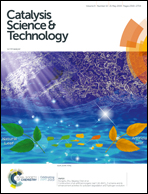Versatile catalysts constructed from hybrid polyoxomolybdates for simultaneously detoxifying sulfur mustard and organophosphate simulants†
Abstract
Chemical warfare agents (CWAs) containing sulfur mustard and organophosphates are among the most toxic materials known to mankind and have caused lots of casualties during wars and terrorist attacks. Development of catalysts with selective oxidation and hydrolysis abilities for detoxification of these two types of CWAs is highly desired. Here, we report a series of carboxylic acid modified polyoxomolybdate derivatives with high catalytic performance in the degradation two typical chemical warfare agent simulants: 2-chloroethyl ethyl sulfide (CEES) and diethyl cyanophosphonate (DECP), at room temperature. Our results demonstrate that CEES can be highly-selectively degraded to the corresponding far less toxic 2-chloroethyl ethyl sulfoxide (CEESO) with the oxidant H2O2 within 12 minutes, and DECP is almost completely hydrolysed to nontoxic products within 10 minutes. The catalytic activities of these compounds were found to be influenced by the metal cations, carboxylic acid ligands and heteroatoms of polyoxoanions. The corresponding order is respectively Co2+ > Ni2+, Zn2+, Mn2+; PABA > Ala, Ac; AsMo > TeMo.



 Please wait while we load your content...
Please wait while we load your content...